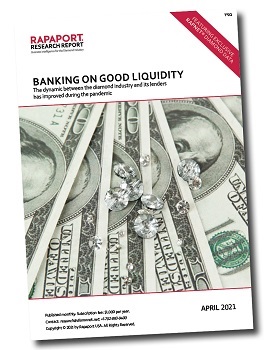Diamantaires Emerge from Crisis with Credit
The diamond trade reduced its reliance on banks during Covid-19 and has adopted better compliance, governance and transparency standards in recent years.RAPAPORT... In the first issue of the Rapaport Research Report, which came out in January 2018, we highlighted the mistrust that existed between the diamond industry and its lenders. Diamantaires argued that the banks had an unjustified high-risk perception of the diamond trade, while the banks pressed the trade to be more efficient and raise its compliance standards. Much has changed in the three years since then, and particularly in the past year amid the coronavirus. The relationship between the two sides appears to have vastly improved. And while historically, diamantaires have complained about a lack of available funds, there now appears to be an oversupply of credit.The diamond industry emerged from the Covid-19 crisis in a healthy position. It was able to reduce its inventory and improve its liquidity even as the volume of trade declined. That translated to a reduced need for financing. Banks provide loans based on a client's inventory and receivables - payments owed for orders. As both measures dropped in 2020, so did the need for the banks' credit facilities.But there are deeper and more important reasons behind the newfound amicability between the two sectors, which we explore in this month's issue of the Rapaport Research Report.The trade has adjusted to operating with less reliance on the banks, thanks to the banks reducing their funding over the past seven years. The industry has also cleaned up its act, putting a greater emphasis on corporate social responsibility, efficiency and transparency. In addition, there has been a marked drop in bankruptcies over the past two years.The lenders that are still working with the diamond trade have taken note. Bankers we interviewed for the report expressed satisfaction with the industry's profile. That is a substantial change in sentiment over a very short time, but the industry cannot rest on its laurels. The need for financing will increase as trading activity improves, and lenders will be keeping an eye on whether the diamond sector can sustain its recent profitability. And they'll want to see diamantaires be even better corporate citizens, continuing to improve their social programs and raise their compliance standards. As Yoram Dvash, president of the World Federation of Diamond Bourses (WFDB), stresses, "we [still] need to be more transparent." That is, even as some banks are considering returning to diamond financing, he reports. The industry should take that as a vote of confidence. But it should also be careful not to fall into its old habit of relying too much on the banks.The trade seems to have found a healthy level of liquidity and leverage, which it needs to maintain to ensure a long-term recovery of the diamond market. The Rapaport Research Report presents proprietary data on polished diamond prices, along with market intelligence and analysis. Subscribe to the report here.Images: Cover of April Rapaport Research Report depicting polished diamonds on pile of dollar bills. (123RF)
Much has changed in the three years since then, and particularly in the past year amid the coronavirus. The relationship between the two sides appears to have vastly improved. And while historically, diamantaires have complained about a lack of available funds, there now appears to be an oversupply of credit.The diamond industry emerged from the Covid-19 crisis in a healthy position. It was able to reduce its inventory and improve its liquidity even as the volume of trade declined. That translated to a reduced need for financing. Banks provide loans based on a client's inventory and receivables - payments owed for orders. As both measures dropped in 2020, so did the need for the banks' credit facilities.But there are deeper and more important reasons behind the newfound amicability between the two sectors, which we explore in this month's issue of the Rapaport Research Report.The trade has adjusted to operating with less reliance on the banks, thanks to the banks reducing their funding over the past seven years. The industry has also cleaned up its act, putting a greater emphasis on corporate social responsibility, efficiency and transparency. In addition, there has been a marked drop in bankruptcies over the past two years.The lenders that are still working with the diamond trade have taken note. Bankers we interviewed for the report expressed satisfaction with the industry's profile. That is a substantial change in sentiment over a very short time, but the industry cannot rest on its laurels. The need for financing will increase as trading activity improves, and lenders will be keeping an eye on whether the diamond sector can sustain its recent profitability. And they'll want to see diamantaires be even better corporate citizens, continuing to improve their social programs and raise their compliance standards. As Yoram Dvash, president of the World Federation of Diamond Bourses (WFDB), stresses, "we [still] need to be more transparent." That is, even as some banks are considering returning to diamond financing, he reports. The industry should take that as a vote of confidence. But it should also be careful not to fall into its old habit of relying too much on the banks.The trade seems to have found a healthy level of liquidity and leverage, which it needs to maintain to ensure a long-term recovery of the diamond market. The Rapaport Research Report presents proprietary data on polished diamond prices, along with market intelligence and analysis. Subscribe to the report here.Images: Cover of April Rapaport Research Report depicting polished diamonds on pile of dollar bills. (123RF)